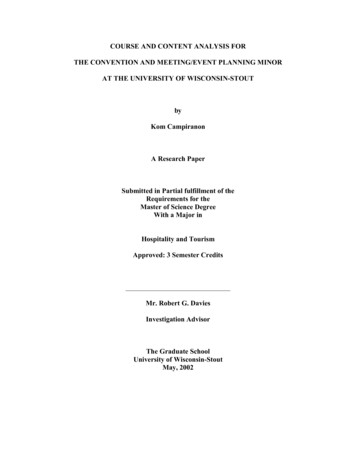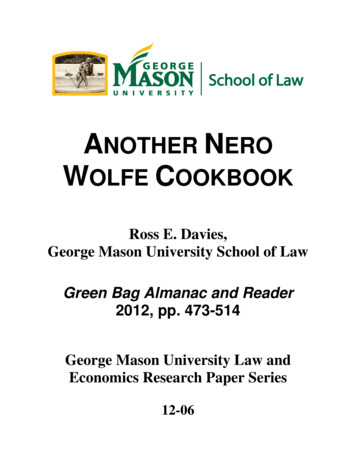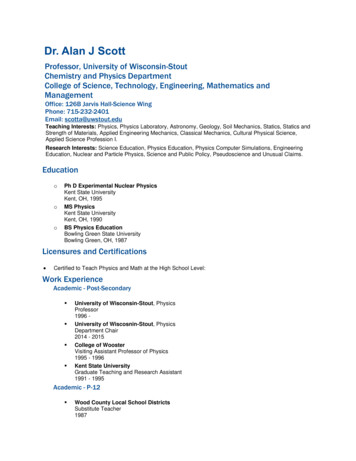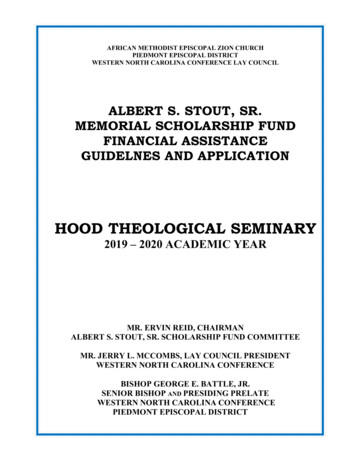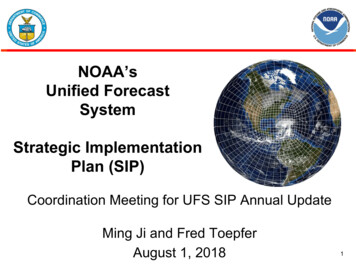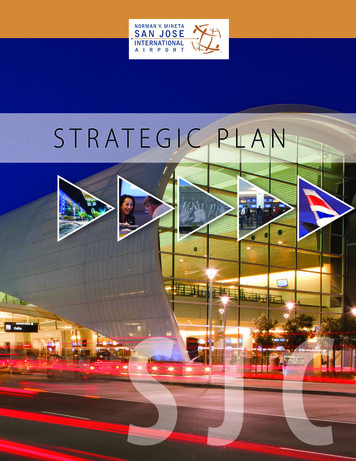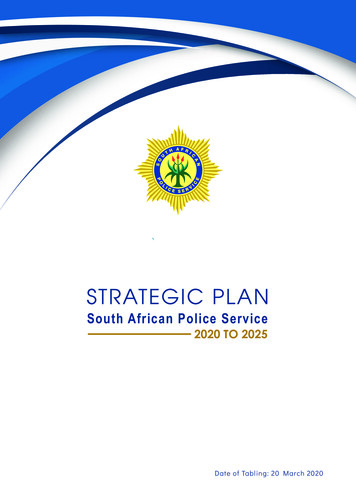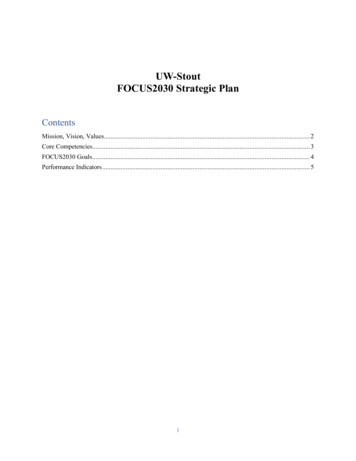
Transcription
UW-StoutFOCUS2030 Strategic PlanContentsMission, Vision, Values. 2Core Competencies. 3FOCUS2030 Goals. 4Performance Indicators . 51
Mission, Vision, ValuesMissionIn progress.VisionUniversity of Wisconsin-Stout prepares lifelong learners, ethical leaders and responsible citizensin an equitable, inclusive, and sustainable environment through collaborative career-focusedprograms that integrate applied learning, theory and research. We will advance our position as afuture-focused polytechnic institution and as a regional, national and international leader inhigher education in a diverse society.Values Learning: The advancement of academic excellence and commitment to inclusive,accessible education as a means to illuminate the lives of all. Skill: The ideals of collaboration, competence and continuous improvement. Industry: The pursuit of innovation, technology and sustainability with a constant eye toan equitable future. Honor: The nobility of spirit, a diversity of people, respect and inclusion for all.2
Core CompetenciesUW-Stout’s core competencies reflect our polytechnic tenets and commitment to the MalcolmBaldrige Performance Excellence Framework. The Baldrige core values of management by fact,valuing people, and focus on the future, provide the foundation for each of ourcompetencies. Our institutional structure ensures that these competencies are embedded in ourpractices and align and integrate across the institution. To achieve these core competencies, wewill continue to address barriers that limit access to equitable, diverse, and inclusiveenvironments.1. Career-focused educationUW-Stout’s uniquely successful career-focused program array features undergraduate andgraduate majors, minors, and certifications that are continually updated, based on input fromour advisory partners, to align with evolving professional career paths.2. Applied LearningWe prepare students to apply theory to practice through experiential opportunities, reflecting ourlab-based minds-on hands-on approach to education, in virtual, hybrid and campus-basedenvironments.3. External PartnershipsUW-Stout’s collaborative partnerships with external experts, businesses, andorganizations are key to fulfilling our mission of preparing students for careers through appliedlearning experiences.4. Collaborative PlanningUW-Stout’s commitment to shared governance, internal and external partnerships,inclusive excellence, and continuous improvement are at the core of our strategic planning anddecision-making processes.3
FOCUS2030 Goals1 Student SuccessDeliver valuable holistic support and integrated learning experiences that engage students inenvisioning new possibilities, achieving their goals, and excelling in our global and diversesociety.2 Employee SuccessFoster an equitable environment that invests in, supports, encourages, and values diversefaculty and staff development opportunities.3 Institutional SustainabilityAchieve financial stability that systematically strengthens the university’s short-term andlong-term financial, social, and environmental outlook in a way that is transparent andresponsible to the university’s mission.4 Equity, Diversity, and InclusivityInvest in, and ensure access to, equitable, diverse, and inclusive learning, student living, andwork environments that reflect our regional and global connections.5 IdentityAdvance UW-Stout's reputation as a polytechnic university by providing students access tocutting edge technology, innovative programs, and collaborative partnerships that support thedevelopment of interdisciplinary knowledge and skills, including a humanistic understandingnecessary to live and work in a diverse, interconnected, and rapidly changing world.4
Performance mentsTotal headcount enrollment and full-timeequivalent enrollment for graduate students andundergraduate students, compared to targets.The Full Time Equivalent for a student is basedon official credits and student level. It iscomputed by dividing the student official creditsat each level by the average number of credithours carried per semester of the various studentlevels. Undergrads would be 15, Master and EdSwould be 12, EdD would be 7.Fiscal sustainabilityJob Placementrates forundergraduateand graduatestudentsPercentage of students self-reporting beingNeed toemployed or continuing their education, from the determine whoFirst Destination Employment surveywill beresponsible forcollecting thisdata forgraduatestudents.Short-term:PARQ to workPercentage of students participating in capstonewithcourses, co-ops/internships, field experiences,Registrationpracticum, service learning, student research,and Recordsstudent teaching, and study abroad prior toand thegraduation.Provost’soffice toLong-term:develop a planExpand this metric to also include a separatefor the longindicator on the percentage of students with aterm approach.professional credential.First to second year retention rate for first time,full-time freshmen for undergrads and first fallto second year (fall or spring) for full-timegraduate students. This is retention at UWStout, not retention in the program.Student successIdentitySix-year graduation rate for first time, full-timefreshmen who start at UW-Stout and graduatefrom UW-Stout, seven-year graduation rates forfull-time graduate students who start at UW-Student SuccessStudentparticipation inexperientiallearning forundergraduatesRetention ratesfirst to secondyear forundergraduateand graduatestudents6-yeargraduation ratesforundergraduates,Next steps (ifapplicable)5Alignment to FOCUS2030goals and Enduring goalsIdentity and StudentsuccessFiscal Sustainability andStudent Success
ProposedIndicatorDefinition7-yeargraduation ratefor graduatesReasons forleaving(faculty/staff)Stout and graduate from UW-Stout.Overall level offaculty/staff jobengagementFaculty/staffsalaries as apercentage ofmarketInternalfaculty/staffsalary equitySCH/FTEMean ratings on the following questions fromthe faculty/staff exit interview survey. Ratingscale 1 strongly disagree 4 strongly agree I had a supportive work environment I had the resources I need to do my jobeffectively (ex: tools, research opportunities,specialized training, support, facilities)(reworded) I had adequate opportunities for training andprofessional developmentUse a new question (TBD) from the new campusclimate survey.Average percent of market of salaries forfaculty/staff, using CUPA and/or MRA data andthe number and percentage of faculty/staff belowthe target percentage of market.Using results of the PARQ internal salary equitymodel:Gender inequity: red/yellow/green by model(based on statistical significance and magnitude)Race/ethnicity inequity: red/yellow/green bymodel (based on statistical significance andmagnitude)Student-credit hours per full-time equivalentemployee. Student credit hours reflect the creditvalue of a course multiplied by the number ofstudents enrolled in that course. For example, ifa 4-credit course enrolls 30 students, thefaculty/staff member would be assigned 120student credit hours. One FTE is equivalent toone faculty/staff working full-time. An FTE of1.0 is equivalent to a full-time faculty/staff,while an FTE of 0.5 signals half of a full6Next steps (ifapplicable)Alignment to FOCUS2030goals and Enduring goalsPARQ to workwith HR toreword thequestion on“resourcesneeded to domy jobeffectively.”Employee SuccessPARQ tocharge the adhoc committeethat is workingon the surveyto identify thequestion.Employee SuccessPARQ todevelop thisstoplightsystem.Recruit and retain a diverseuniversity populationRecruit and retain a diverseuniversity populationRecruit and retain a diverseuniversity population;financial sustainability
ProposedIndicatorFaculty andstaff of colorProgram costRevenue/costSources ofrevenueFinancialviabilityEnvironmentfor EDIDefinitionNext steps (ifapplicable)workload. From UW System IAIS reports.Percent of faculty and staff of color (includesfaculty, limited appointments, instructionalacademic staff, professional academic staff,university staff)Alignment to FOCUS2030goals and Enduring goalsRecruit and retain a diverseuniversity populationEach program’s cost to the university isdetermined by calculating the cost of each creditrequired by the Program Plan using thecost/SCH rates for each course prefix. Allprograms are calculated at 80 credits (which wasmade standard for all programs). GeneralEducation courses are considered equivalentacross all programs so the cost for Gen Edcredits are not included.This metric focuses on department-level costsand revenue. This is based on an understandingthat current funding strings are associated withdepartments not programs. Only revenue andexpenses associated with the generation ofregular campus tuition is used in this calculation.It does include Enrollment Growth, Access toLearning, and Tuition Differential, and excludesCustomized Instruction.Sources of revenue and expenses resulting in aprofit and loss statement.Composite Financial Index (CFI) (measuresfinancial health) and Primary Reserve Ratio,which is one of the core ratios included in theCFI. The CFI utilizes four core ratios: theprimary reserve ratio, the viability ratio, thereturn on net assets ratio,and the net operatingrevenues ratio.Fiscal sustainabilityShort-term:Student survey questions: I feel respected by 1)students at UW-Stout, 2) instructors at UWStout, 3) staff at UW-Stout, and 4) campusleadership at UW-Stout.EDI, Enduring goals –recruit and retain a diverseuniversity population andcampus climateFaculty/staff survey question: UW-Stout investsin equitable, diverse, and inclusive learning,living and work environments [response on a 57Fiscal sustainabilityFiscal sustainabilityFiscal sustainability
ProposedIndicatorDefinitionNext steps (ifapplicable)Alignment to FOCUS2030goals and Enduring goalspoint scale]Measured as follows:Gap in scores among: Job roles (academic staff, faculty, limitedappointment, limited term employment,university staff) Division or college Disability status Sexual orientation Gender identity Race/ethnicity Note: analysis only to be run where thereare at least 10 individuals in the group.Additionally, a non-response option willbe included in the comparisons for thedemographic groups.Long term:This metric may be expanded based on theProgram Theory of Change work, performanceevaluation process and other EDI work.Greenhouse gasemissions –scope 1, 2, 3Scope one, two and three Greenhouse GasEmissions associated with the American Collegeand University Presidents' Climate Commitment.Scope 1 is direct emissions, scope 2 is indirectemissions mostly associated with purchasedutilities, and scope 3 is other indirect emissionsfrom sources that are not owned or controlled bythe campus but are central to campus operations.Employer ratingof overallpreparation foremploymentMean ratings on “Degree employee exhibitededuc. preparation to perform role withinorganization” from the Alumni Follow UpEmployer Survey, conducted by the PARQoffice.Training andDevelopmentShort-term:Track the number of training and developmentsessions offered, number of attendees whichwould be obtained from the registration8Enduring goal –environmentalsustainabilityPARQ topropose analternativegiven changesto the AlumniFollow UpSurvey.PARQ tocharge the HRoffice todevelop aRecruitment and retention,identify, student successEmployee Success, EDI
ProposedIndicatorEmployeeSuccessCo-ops,internships andfieldexperiencesDefinitionNext steps (ifapplicable)software. Develop a process to have a standardsurvey that goes out after each event. We wouldinclude all professional development that goesthrough the Learning Stream software system.We would encourage as many people as possibleto use the Learning Stream software system.Also, tag training and development sessions asEDI and report these data separately.system for thisshort-termplan. PARQ towork with theProvost’soffice on thelonger-termmetric.Long-term:Expand to include a metric to track onlinetraining credentials for instructors that teachonline.Subset of these questions from the GreatColleges to Work for Survey:five-point agreement scale (Strongly Agree,Agree, Sometimes Agree/Sometimes Disagree,Disagree, Strongly Disagree). Additionally,there is a Not Applicable response option. If wecan’t do the Great Colleges to work for survey,we would use similar questions on an internalsurvey.o I am given the opportunity to developmy skills at this institution.o I understand the necessaryrequirements to advance my career.Overall rating on co-ops, internships and fieldexperiences from the Career Services datacollection process.9Alignment to FOCUS2030goals and Enduring goalsEmployee SuccessStudent success andIdentity
Stout and graduate from UW-Stout. Reasons for leaving (faculty/staff) Mean ratings on the following questions from the faculty/staff exit interview survey. Rating scale 1 strongly disagree 4 strongly agree I had a supportive work environment I had the resources I need to do my job effectively (ex: tools, research opportunities,
